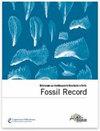Osteology of the Permian temnospondyl amphibian Glanochthon lellbachae and its relationships
IF 2.1
4区 地球科学
Q1 PALEONTOLOGY
引用次数: 3
Abstract
Abstract. The early Permian Meisenheim Formation of the Saar–Nahe Basin (Germany) is famous for its richness in vertebrate fossils, among which the temnospondyls were present with microvores and fish-eating apex predators. The latter trophic guild was occupied exclusively by the genus Sclerocephalus in that basin within a long time interval up to M8, whereas in M9, a new taxon, Glanochthon lellbachae, appeared. This taxon is defined by (1) a preorbital region 1.8–2.0 times as long as the postorbital skull table, (2) dermal ornament with tall radial ridges, (3) a prefrontal anteriorly wider with straight lateral margin, (4) a squamosal posteriorly only half as wide as the quadratojugal, (5) phalanges of manus and pes long and gracile, (6) carpals unossified in adults, and (7) tail substantially longer than skull and trunk combined. Phylogenetic analysis finds that G. lellbachae forms the basal sister taxon of the stratigraphically younger G. angusta and G. latirostre and that this clade nests within the paraphyletic taxon Sclerocephalus, with S. nobilis forming the sister taxon of the genus Glanochthon (urn:lsid:zoobank.org:act:3038F794-17B9-4FCA-B241-CCC3F4423651; registration date: 15 March 2021).二叠纪temnospondyl两栖动物Glanochthon lellbachae的骨学及其关系
摘要德国萨尔-纳河盆地早二叠世Meisenheim组以丰富的脊椎动物化石而闻名,其中temnospondyls存在微食动物和食鱼的顶端捕食者。在M8之前的很长一段时间间隔内,该盆地的后一个营养类群完全被硬头类占据,而在M9中出现了一个新的分类群Glanochthon lellbachae。这个分类群的定义是:(1)眶前区域是眶后颅骨表的1.8-2.0倍长,(2)真皮装饰有高的径向脊,(3)前额前部宽,有直的外侧边缘,(4)鳞片后部仅为方形颚的一半宽,(5)手和足的指骨长而柔软,(6)成年未分化的腕骨,(7)尾巴比颅骨和躯干加起来长得多。系统发育分析发现,G. lellbachae是地层较年轻的G. angusta和G. latirostre的基础姐妹分类群,该分支群在副进化分类群sclerocephalus中巢,S. nobilis形成Glanochthon属的姐妹分类群(urn:lsid:zoobank.org:act: 3038f794 - 17b9 - 4fca - b244 - ccc3f4423651;注册日期:2021年3月15日)。
本文章由计算机程序翻译,如有差异,请以英文原文为准。
求助全文
约1分钟内获得全文
求助全文
来源期刊

Fossil Record
PALEONTOLOGY-
CiteScore
3.60
自引率
7.10%
发文量
18
审稿时长
14 weeks
期刊介绍:
Fossil Record (FR) is the palaeontological journal of the Museum für Naturkunde Berlin. This journal was founded in 1998 under the name Mitteilungen aus dem Museum für Naturkunde Berlin, Geowissenschaftliche Reihe and appears with two issues each year. Fossil Record publishes original papers in all areas of palaeontology including the taxonomy and systematics of fossil organisms, biostratigraphy, palaeoecology, and evolution. All taxonomic groups are treated, including invertebrates, microfossils, plants, and vertebrates.
 求助内容:
求助内容: 应助结果提醒方式:
应助结果提醒方式:


